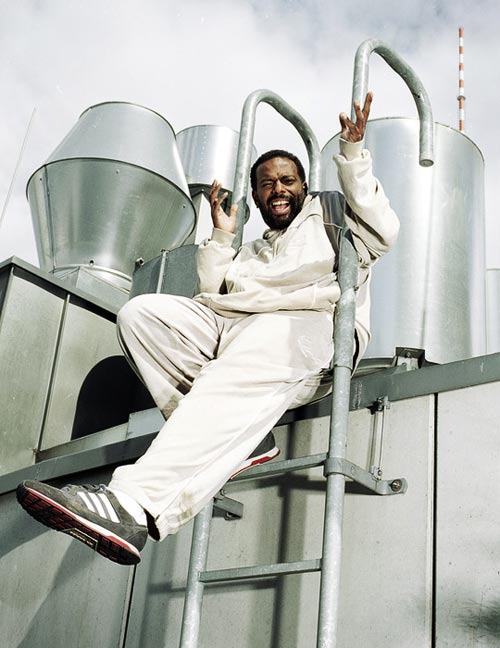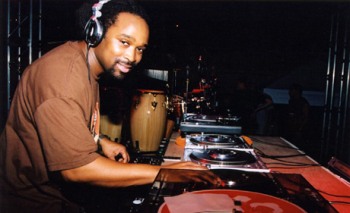THEO PARRISH feat. YAMINI NAYAR / “Children Of The Drum”

I’ve been thinking all week about a way to explain Theo Parrish’s music. I haven’t come up with a thing. What I want to say is: “Are you kidding?! Listen to this!” But of course, anyone could say that about anything they like. I can tell you what I think about when I hear Theo’s records. I think about the earliest days of rap. Not hip-hop. And there is a difference.
Back in the park days, MCs rapped over breaks from soul, pop, jazz and funk records. When hip-hop moved to the recording studio, the record companies hired bands to replay the breaks. Of course, that defeated the purpose and accounts for the reason that many early hip-hop records sound at least a little fake. It’s because they were. If you ever have the opportunity to hear tapes of actual park jams, they have very little in common with the bouncy, novelty feel of most early recorded hip-hop. The tapes sound raw and chaotic. There are no real ‘songs’ to speak of. Just breaks and voices. The crowd sometimes louder than the MCs. The DJs yelling at people to quit dancing so close to the stage because they’re making the needle skip.
Anyhow, four years or so later, along came Run-D.M.C.’s “Sucker M.C.’s” – the song that changed everything. (Although, in it’s own way, “Sucker M.C.’s” was no more of a ‘song’ than those old hip-hop jams were.) “Sucker M.C.’s” was nothing but a drum machine, two voices and a whole lot of empty space. That empty space was spooky. Weird. It was a void that most records – hip-hop or otherwise – made sure to cover up. The empty space was like a little whisper in your ear: “You’re listening to a machine. You’re listening to a machine. You’re listening to a machine.” But a strange thing happened. We listened to Run-D.M.C. and we decided we liked this new machine music.
Theo takes me back to those days. He makes no attempt to hide the machine. Listen to “Dreamer’s Blues.” That hi-hat sounds like something you’d hear in an auto assembly plant. Not only does Theo not try to soften the sound, I’d bet he went out of his way to make it as dry and cold as possible. Listen to the pulsing keyboard effect. It has a glitch in it. Do you hear it? Each time it hits, there’s a splotchy burping effect like when you cut a tape reel in the middle of a sound. Back in the day, sonic atonalities like these were the byproduct of novice beat makers using primitive drum machines. In other words, cats were just making it up as they went along. These days, someone as skillful as Theo can make a record sound like anything he wants it to. He could soften the hi-hat in a few minutes. It’d take him a couple of keyboard strokes to ‘fix’ the splotches. But he doesn’t. Why?
My theory is Theo has no interest in hiding the machine. He likes the machine. He just wants to make it dance. Remember Herbie Hancock’s landmark video for “Rockit”? The one where the robot arms and computer screens were getting down like they were at the club? For me, Theo’s records sound like that video looked. I listen to Theo’s records and feel like I can hear the subway singing or the sidewalk crying. When I click buttons on the ATM machine, or send text messages on my cellphone, or type letters on my keyboard I feel like I’m inside of Theo’s “Space Ghost.” I’m flesh and blood, they’re wires and bolts, and we get along just fine.
I know all of this sounds sci-fi and ‘out there’ and anti-music and so on. It’s not. As Theo made clear in the quote I posted last week, he’s not only aware of the musical legacy of his ancestors, he considers himself a part of it. Traditionalists may blanch at Theo’s methods, but the truth is, we’ve been using machines to make music for a long, long time. It’s just that the familiar becomes invisible. We get used to something and then decide it isn’t a machine anymore. It’s a ‘piano.’ It’s a set of ‘trap drums.’ It’s a ‘saxophone.’ What is a saxophone? A complex device with numerous valves and keys used to produce sound. And what is it made of? Brass – a man-made alloy of copper and zinc. In other words, it’s a machine.
I think of it like this: Theo’s music is his way – our way – to make sense of the concrete jungle our world as become. Despite it all, we haven’t changed that much. We are still, as Theo says, children of the drum. But the machines – the robots and computers – are here to stay. It’s getting to the point where we can’t live without them. Corporations use them to make money. Governments use them to wage war, collect taxes or land on the moon. Individuals use them to get from place to place, to prepare food, to make their daily work easier or to entertain themselves. As for Theo, he makes them dance.
—Mtume ya Salaam
Tracks:
—“Dreamer’s Blues.” From Parallel Dimensions. Originally released in 2000. Reissued in 2004 by Ubiquity Records. This track is only available on the vinyl version of the album.
—“Space Ghosts.” From Parallel Dimensions.
—“Children Of The Drum.” 12” single. Originally released in 1997. Recently reissued on Sound Signature recordings and also available on Pure Filth, a compilation of Detroit house music.
But can he play?
Musician Harold Battiste has a sign he used to display in his office at the University of New Orleans. When dealing with the music, Harold’s ultimate question was: but can he (or she) play?
I agree with the meta-context, the use of machines, the emphasis on re-contextualizing sound but…. My discomfort or dislike of Theo Parrish’s music is that it sounds amateurish to me both from the musical and the engineering standpoint. The rhythms seem simplistic, the melodies weak, and the harmony rudimentary. But far more disturbing to me is the muddled sound. All three tracks seem tentative and indistinct. It’s like Theo Parrish has good ideas but doesn’t have the chops to convincingly put across the ideas. But I know better. Theo knows what he is doing. It may sound simple, but there is something else going on. The catch for me is that I'm not particularly interested in Theo's something else, and that's on me, not Theo.
DJ Spinna is an example of someone working in a similar vein to Theo Parrish. I enjoy a lot of Spinna’s work, probably just like Mtume enjoys Parrish’s work. Here are two Spinna tracks: “Platinum” from Compositions 3 and “Final Events (Outro)” from Intergalactic Soul. DJ Spinna is my rejoinder. I have nothing else to say about Theo Parrish.
—Kalamu ya Salaam
This entry was posted on Sunday, March 25th, 2007 at 12:33 am and is filed under Contemporary. You can follow any responses to this entry through the RSS 2.0 feed. You can leave a response, or trackback from your own site.
One Response to “THEO PARRISH feat. YAMINI NAYAR / “Children Of The Drum””
March 25th, 2007 at 6:50 pm
i’m glad theo p’s work was up for conversation these past two weeks. I’ve heard nothing but good about his live dj sets – even from those who don’t particularily care for his own releases.
I consider house, electro, and techno the true “neo-soul.” I recommend checking out Drexciya. The Other People Place is 1/2 of Drexciya making warmer, creamier joints – a good introduction if skeptical of ‘techno’ in the first place.
Leave a Reply
| top |